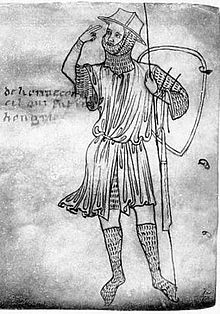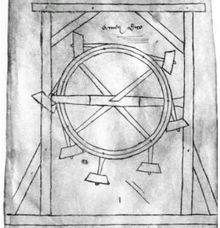Villard de Honnecourt


Villard de Honnecourt (Wilars dehonecort, fol. 1v; Vilars de Honecourt, fol. 15v) was a 13th-century artist from Picardy in northern France. He is known to history only through a surviving portfolio of 33 sheets of parchment containing about 250 drawings dating from the 1220s/1240s, now in the Bibliothèque Nationale, Paris (MS Fr 19093). The great variety of subjects (religious and secular figures suitable for sculpture, and architectural plans, elevations and details, ecclesiastical objects and mechanical devices, some with annotations), makes it difficult to determine its purpose. Other subjects such as animals and human figures also appear.
The traditional view, since the discovery of the portfolio in the mid-19th century, is that Villard was an itinerant architect/mason/builder, but there is no evidence of him ever working as an architect or in any other identifiable profession. None the less, it is clear from his drawings that he was interested in architecture and that he traveled to some of the major ecclesiastical building sites of his day to record details of these buildings. His drawing of one of the west facade towers of Laon Laon Cathedral cathedral and those of a radiating chapels and main vessel bay, interior and exterior, of Reims Reims Cathedral are of particular interest.
Villard tells us, with pride, that he had been in many lands (Jai este en m[u]lt de tieres) and that he made a trip to Hungary where he remained many days (maint ior), but he does not say why he went there or who sent him. It has recently been proposed that he may have been a lay agent or representative of the cathedral chapter of Cambrai Cambrai Cathedral to obtain a relic of St. Elizabeth St. Elizabeth of Hungary who had made a donation to the cathedral chapter and to whom the chapter dedicated one of the radiating chapels in their new cathedral chevet.
Among the mechanical devices Villard sketched are a perpetual-motion machine, a water-driven saw, a number of automata, lifting devices, war engines (a trebuchet) as well as a number of anatomical and geometric sketches for portraiture and architecture. The claim that he drew a simple escapement mechanism, the first known in the West, is now questioned.
Villard's vast diversity in his sketchbook has caused him to be compared to such great minds as Leonardo Da Vinci, who also specialized in many different categories of art and science.
See also
- Medieval technology
- Guido da Vigevano
- Taccola
- Francesco di Giorgio Martini
- Leonardo da Vinci
- South pointing chariot
External links
- [http://www.villardman.net/ Dr. Carl F. Barnes, Jr. website: The Portfolio of Villard de Honnecourt. Barnes is the undisputed authority on this enigmatic figure. See Barnes's The Portfolio of Villard de Honnecourt, A New Critical Edition and Color Facsimile. (Ashgate Publishing ltd.), 2009.
- AVISTA is a scholarly Villard de Honnecourt society for interdisciplinary study of medieval technology, science and art.
- L'album de Villard de Honnecourt, by Claude Gagne, including reproductions of Villard's drawings.
- La Cathedrale et Villard de Honnecourt at the French National Library has a sizeable number of sheets from Villard's portfolio.
- Association Villard de Honnecourt à Honnecourt" mail: villarddehonnecourt@free.fr
